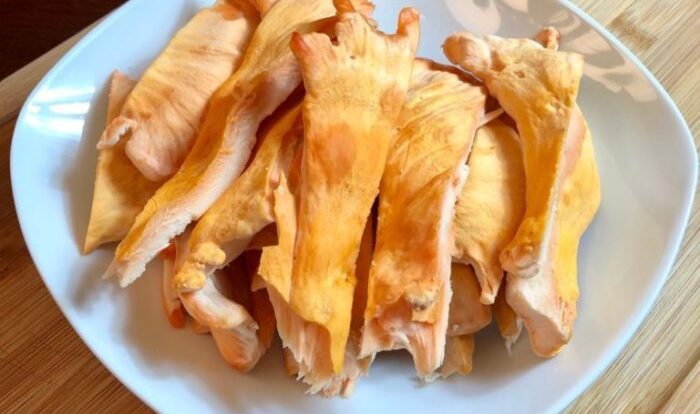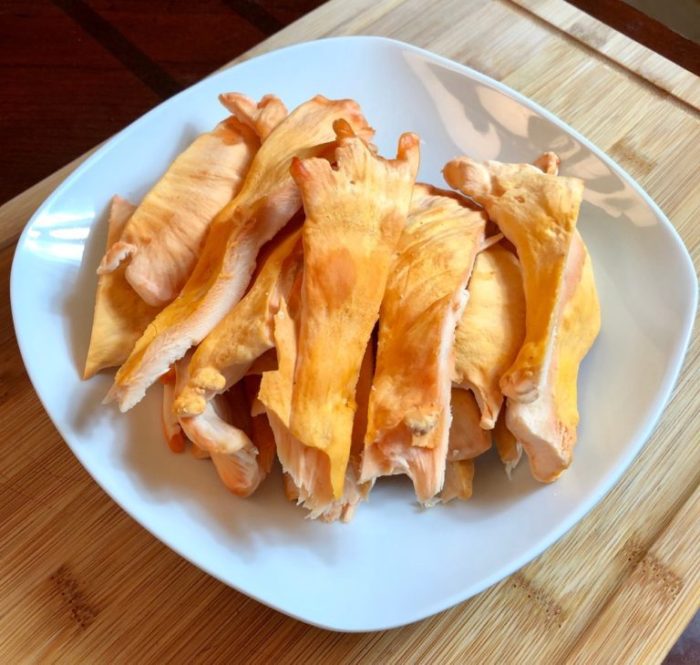
Chicken of the woods recipe, a delicacy in the culinary world, invites you on a wild and flavorful journey. With its vibrant colors and intriguing texture, this edible fungus has captured the attention of gourmands and nature enthusiasts alike. Join us as we delve into the captivating world of chicken of the woods, exploring its nutritional wonders, cooking techniques, and the thrill of foraging for this culinary gem.
Embark on a gastronomic adventure with our comprehensive guide to chicken of the woods recipe, where we’ll uncover the secrets of preparing this delectable ingredient. From sautéing to grilling and roasting, we’ll guide you through every step, ensuring a culinary masterpiece every time.
Recipe Variations
Chicken of the woods is a versatile mushroom that can be prepared in a variety of ways. From simple sautéed dishes to hearty soups and stews, there’s a recipe for every taste and occasion. Here’s a table outlining some popular chicken of the woods recipes:
| Recipe | Ingredients | Cooking Method | Serving Suggestions |
|---|---|---|---|
| Sautéed Chicken of the Woods | Chicken of the woods mushrooms, olive oil, salt, pepper | Sautéed in a pan until tender | Serve as a side dish or over pasta |
| Chicken of the Woods Soup | Chicken of the woods mushrooms, vegetable broth, onions, carrots, celery | Simmered in a pot until the mushrooms are tender | Serve with crusty bread or crackers |
| Chicken of the Woods Stew | Chicken of the woods mushrooms, beef broth, potatoes, carrots, onions | Simmered in a pot until the mushrooms and vegetables are tender | Serve with rice or noodles |
| Chicken of the Woods Pizza | Chicken of the woods mushrooms, pizza dough, tomato sauce, mozzarella cheese | Baked in the oven until the pizza crust is golden brown | Serve as an appetizer or main course |
| Chicken of the Woods Tacos | Chicken of the woods mushrooms, tortillas, salsa, cheese | Sautéed chicken of the woods mushrooms are placed in tortillas and topped with salsa and cheese | Serve as an appetizer or main course |
Each of these recipes offers a unique flavor and texture. Sautéed chicken of the woods is a quick and easy way to enjoy the mushroom’s earthy flavor. Chicken of the woods soup is a hearty and flavorful meal that’s perfect for a cold winter day.
Chicken of the woods stew is a hearty and filling dish that’s perfect for a family dinner. Chicken of the woods pizza is a delicious and easy way to enjoy the mushroom’s unique flavor. Chicken of the woods tacos are a fun and easy way to enjoy the mushroom’s versatility.
Nutritional Value and Health Benefits

Chicken of the woods is a nutritional powerhouse, boasting an impressive array of vitamins, minerals, and antioxidants. It’s particularly rich in vitamin D, which is essential for bone health and immune function. Additionally, it contains significant amounts of vitamin C, an antioxidant that helps protect cells from damage.
Minerals
Chicken of the woods is also a good source of minerals, including potassium, phosphorus, and iron. Potassium is vital for maintaining healthy blood pressure, while phosphorus supports bone and muscle health. Iron plays a crucial role in red blood cell production and oxygen transport.
For a more in-depth guide, I’ve found this chicken of the woods recipe to be incredibly helpful. It provides step-by-step instructions, along with tips on how to identify and harvest the chicken of the woods mushroom. I’ve tried it myself and the results were fantastic.
Antioxidants
This mushroom is packed with antioxidants, including ergothioneine and beta-glucans. Ergothioneine is a unique antioxidant that protects cells from oxidative damage, while beta-glucans enhance immune system function and reduce inflammation.
Cooking Techniques

Chicken of the woods is a versatile mushroom that can be cooked in various ways. It can be sautéed, grilled, roasted, or fried. Each cooking method imparts a unique flavor and texture to the mushroom.
To enhance the flavor of chicken of the woods, it is important to remove any bitterness. This can be done by parboiling the mushrooms before cooking them. To parboil, simply boil the mushrooms in water for 5-10 minutes, then drain them and pat them dry.
Sautéing, Chicken of the woods recipe
- Heat a large skillet over medium heat.
- Add 1 tablespoon of olive oil to the skillet.
- Add the chicken of the woods mushrooms to the skillet and cook until they are browned on all sides.
- Add your desired seasonings to the skillet and cook for an additional 2-3 minutes.
- Serve the sautéed chicken of the woods mushrooms immediately.
Grilling
- Preheat your grill to medium-high heat.
- Brush the chicken of the woods mushrooms with olive oil.
- Grill the chicken of the woods mushrooms for 5-7 minutes per side, or until they are cooked through.
- Serve the grilled chicken of the woods mushrooms immediately.
Roasting
- Preheat your oven to 400 degrees Fahrenheit.
- Toss the chicken of the woods mushrooms with olive oil, salt, and pepper.
- Spread the chicken of the woods mushrooms on a baking sheet.
- Roast the chicken of the woods mushrooms for 15-20 minutes, or until they are cooked through.
- Serve the roasted chicken of the woods mushrooms immediately.
Pairing and Accompaniments
Chicken of the woods pairs well with a variety of ingredients and side dishes. Its meaty texture and earthy flavor make it a versatile ingredient that can be used in a variety of dishes.
One of the most popular ways to serve chicken of the woods is with a simple sauce or marinade. A simple olive oil and lemon juice marinade can help to enhance the natural flavor of the mushroom, while a more complex sauce, such as a mushroom gravy or a cream sauce, can add richness and depth of flavor.
Side Dishes
Chicken of the woods can also be paired with a variety of side dishes. Some popular options include:
- Pasta:Chicken of the woods can be added to pasta dishes for a hearty and flavorful meal. Try it with a simple marinara sauce or a more complex cream sauce.
- Rice:Chicken of the woods can also be added to rice dishes. Try it with a simple stir-fry or a more complex risotto.
- Vegetables:Chicken of the woods pairs well with a variety of vegetables. Try it with roasted vegetables, sautéed vegetables, or a vegetable stir-fry.
- Bread:Chicken of the woods can be used to make a variety of bread dishes. Try it in a mushroom bread, a mushroom soup, or a mushroom quiche.
Flavor Combinations
When pairing chicken of the woods with other ingredients, it is important to consider the flavor combinations. Chicken of the woods has a meaty texture and an earthy flavor, so it pairs well with ingredients that have similar flavors. Some good flavor combinations for chicken of the woods include:
- Earthy flavors:Chicken of the woods pairs well with other earthy flavors, such as mushrooms, truffles, and nuts.
- Umami flavors:Chicken of the woods also pairs well with umami flavors, such as soy sauce, miso, and Parmesan cheese.
- Sweet flavors:Chicken of the woods can also be paired with sweet flavors, such as honey, maple syrup, and fruit.
By considering the flavor combinations, you can create a delicious and balanced meal with chicken of the woods.
Foraging and Sustainability: Chicken Of The Woods Recipe
Chicken of the woods is a sought-after mushroom that can be found in forests around the world. It’s a large, fleshy mushroom with a bright orange cap and a white or yellow underside. Chicken of the woods is edible and has a meaty, chicken-like flavor.If
I’m a huge fan of trying new recipes, especially when they involve unique ingredients. If you’re looking for a delicious and versatile dish, I highly recommend checking out this chicken of the woods recipe . It’s a great way to enjoy the flavors of the forest in a satisfying and healthy meal.
you’re interested in foraging for chicken of the woods, it’s important to know how to identify it correctly. The mushroom has a few key characteristics that set it apart from other species. First, it has a large, shelf-like cap that can grow up to 12 inches in diameter.
The cap is typically bright orange or yellow, and it has a velvety texture. The underside of the cap is white or yellow, and it has small, round pores.Chicken of the woods typically grows on dead or dying trees. It can be found in both deciduous and coniferous forests.
The mushroom is most common in the fall, but it can also be found in the spring and summer.When foraging for chicken of the woods, it’s important to be mindful of sustainable harvesting practices. This means only taking what you need and leaving the rest of the mushroom for other foragers and wildlife.
It’s also important to avoid damaging the tree that the mushroom is growing on.
Sustainable Harvesting Practices
* Only take what you need.
- Leave the rest of the mushroom for other foragers and wildlife.
- Avoid damaging the tree that the mushroom is growing on.
- Cut the mushroom close to the base, but leave the root intact.
- Handle the mushroom carefully to avoid bruising it.
Conclusive Thoughts

As we conclude our exploration of chicken of the woods recipe, let’s remember that this wild mushroom is not just a culinary delight but also a testament to nature’s abundance. By embracing sustainable harvesting practices, we can ensure that future generations can continue to enjoy this unique and flavorful gift from the forest.
Q&A
Is chicken of the woods safe to eat?
Yes, chicken of the woods is safe to eat when properly identified and cooked. It’s important to note that some people may experience allergic reactions, so it’s recommended to try a small amount first.
What does chicken of the woods taste like?
Chicken of the woods has a mild, slightly nutty flavor and a chewy texture that resembles chicken. It absorbs flavors well, making it a versatile ingredient in various dishes.
How can I identify chicken of the woods?
Chicken of the woods is characterized by its bright orange or yellow coloration and shelf-like shape. It typically grows on dead or dying hardwood trees, especially oaks.